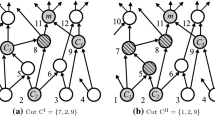Abstract
Binary Decision Diagrams (BDDs) are the state-of-the-art data structure for representation and manipulation of Boolean functions. In general, exact BDD minimization is NP-complete. For BDD-based technology, a small improvement in the number of nodes often simplifies the follow-up problem tremendously. This paper proposes an elitism-based evolutionary algorithm (EBEA) for BDD minimization. It can efficiently find the optimal orderings of variables for all LGSynth91 benchmark circuits with a known minimum size. Moreover, we develop a distributed model of EBEA, DEBEA, which obtains the best-ever variable orders for almost all benchmarks in the LGSynth91. Experimental results show that DEBEA is able to achieve super-linear performance compared to EBEA for some hard benchmarks.
Similar content being viewed by others
References
Bolling, B. and I. Wegener. (1996). “Improving the Variable Ordering of OBDDs is NP-Complete.” IEEE Trans. Computer. 45, 993–1002.
Bolling, B., M. Löbbing, and I. Wegener. (1996). “On the Effect of Local Changes in the Variable Ordering of Ordered Decision Diagrams.” Inform. Processing Lett. 59, 233–239.
Bryant, R.E. (1986). “Graph-Based Algorithms for Boolean Function Manipulation.” IEEE Trans. Comput. 35, 677–691.
Bryant, R.E. (1992). “Symbolic Boolean Manipulation with Ordered Binary-Decision Diagrams.” ACM, Comp. Surveys 24, 293–318.
Brayton, R.K., G.D. Hachtel, C.T. McMullen, and A.L. Sangiovanni-Vincentelli. (1984). Logic Minimization Algorithms for VLSI Synthesis. Boston: Kluwer Academic Publishers.
Culberson, J. (1993). “Crossover Versus mutation: Fueling the Debate: TGA versus GIGA.” In Proceedings of the 5th International Conference on Genetic Algorithms ICGA-93, pp. 632.
Drechsler, R., N. Drechsler, and W. Günther. (2000).“Fast Exact Minimization of BDDs.” IEEE Trans. Computer-Aided Designs 19, 384–389.
Drechsler, R., W. Günther, and F. Somenzi. (2001). “Using Lower Bounds During Dynamic BDD Minimization.” IEEE Trans. Computer-Aided Designs 20, 51–57.
Drechsler, R. and W. Günther. (2001). “History-Based Dynamic BDD Minimization.” VLSI Journal, 31, 51–63.
Davis, L. (1985). “Applying Adaptive Algorithms To Epistatic Domains.” In Proceedings of the International Joint Conference on Artificial Intelligence, pp. 162-164.
Drechsler, R. and N. Gockel. (1997). “Minimization of BDDs by Evolutionary Algorithms.” In International Workshop on Logic Synthesis (IWLS'97).
Eshelman, L.J. (1991). “The CHC Adaptive Search Algorithm: How to Have Safe Search When Engaging in Nontraditional Genetic Recombination.” In Foundations of Genetic Algorithms FOGA-I, pp. 265-283.
Friedman, S.J. and K.J. Supowit. (1990). “Finding the Optimal Variable Ordering for Binary Decision Diagrams.” IEEE Trans. Comput. May, 710-713.
Fujita, M., Y. Matsunaga, and T. Kakuda. (1991). “On Variable Ordering of Binary Decision Diagrams for the Application of Multi-Level Synthesis.” In European Conf. Design Automat., pp. 50-54.
Fogel, D. B. (1988). “An Evolutionary Approach to the Traveling Salesman Problem.” Biological Cybernetics 60, 139–144.
Fogel, D.B. (1990). “AParallel Processing Approach to a MultipleTraveling Salesman Problem Using Evolutionary Programming.” In L. Canter (ed.), Proceedings on the Fourth Annual Parallel Processing Symposium, pp. 318-326.
Fogel, D. B. (1993). “Applying Evolutionary Programming to Selected Traveling Salesman Problems.” Cybernetics and Systems 24, 27–36.
Goldberg, D.E. and R. Lingle Jr. (1985). “Alleles, Loci, and the Traveling Salesman Problem.” In Proceedings of the 1st International Conference on Genetic Algorithms ICGA-85, pp. 154-159.
Günther, W. and R. Drechsler. (1999). “Minimization of Free BDDs.” In '99. Asia and South Pacific vol. 1, pp. 323–326.
Hung, N.N. William, Xiaoyu Song, El Mostapha Aboulhamid, and Michael A. Driscoll. (2002). “BDD Minimization by Scatter Search.” IEEE Trans. CAD 21(8), 974–979.
Ishiura, N., H. Sawada, and S. Yajima. (1991). “Minimization of Binary Decision Diagrams Based on Exchange of Variables.” In Proc. Int. Conf. Computer-Aided Design, pp. 472-475.
Jeong, S.-W., T.-S. Kim, and F. Somenzi. (1993). “An Efficient Method for Optimal BDD Ordering Computation.” In Proc. Int. Conf. VLSI and CAD.
Kebschull, U., E. Schubert, and W. Rosenstiel. (1992). “Multilevel Logic Synthesis Based on Functional Decision Diagrams.” In Proc. European Design Automation Conf., pp. 43-47.
Kumar V., A. Grama, A. Gupta, and G. Karypis. (1994). Introduction to Parallel Computing: Design and Analysis of Algorithms. Redwood City, California: Benjamin/Cummings Publishing Co.
Lin, S.S. and C.J. Wei. (2001). “Improved Algorithm for Binary Decision Diagram Minimization Problem.” In National Computer Symposium, pp. A068-A079.
Möller, D. and R. Drechsler. (1994). “Symmetry Based Variable Ordering for ROBDD's.” In Proc. IFIPWorkshop on Logic and Architecture Synthesis, pp. 47-53.
Oliver, I.M., D.J. Smith, and J.R.C. Holland. (1987). “AStudy of Permutation Crossover Operators on the Traveling Salesman Problem.” In Proceedings of the 2nd International Conference on Genetic Algorithms, ICGA-87, pp. 224-230.
Panda, S. and F. Somenzi. (1995). “Who are the Variables in Your Neighborhood.” In Int. Conf. Computer-Aided Design, pp. 74-77.
Rudell, R. (1993). “Dynamic Variable Ordering for Ordered Binary Decision Diagrams.” Int. Conf. Computer-Aided Design, pp. 42-47.
Scholl, C., D. Möller, and P. Molitor. (1999). “BDD Minimization Using Symmetries.” IEEE Trans. Computer-Aided Designs of Integrated Circuits and Systems 18(2), 81–99.
Somenzi, F. (2001a). “CUDD: CU Decision Diagram Package-Release 2.3.1.” Technical report, Dept. of Electrical and Computer Engineering, University of Colorado, Boulder, Colorado.
Somenzi, F. (2001b). Web site: http://vlsi.colorado.edu/~fabio.
Thierens, D. and D.E. Goldberg. (1994). “Elitist Recombination: An Integrated Selection Recombination GA.” In Proceedings of the 1st IEEE World Congress on Computational Intelligence, pp. 508-512.
Whitley, D., T. Starkweather, and D'A. Fuquay. (1989). “Scheduling Problems and Traveling Salesman: The Genetic Edge Recombination Operator.” In Proceedings of the 3rd International Conference on Genetic Algorithms ICGA-89, pp. 133-140.
Yang, J.M. and C.Y. Kao (2000). “Integrating Adaptive Mutation and Family Competition into Genetic Algorithms as Function Optimizer.” Soft Computing 4, 89–102.
Author information
Authors and Affiliations
Corresponding author
Rights and permissions
About this article
Cite this article
Chen, ST., Lin, SS., Huang, LT. et al. Towards the Exact Minimization of BDDs—An Elitism-Based Distributed Evolutionary Algorithm. Journal of Heuristics 10, 337–355 (2004). https://doi.org/10.1023/B:HEUR.0000026899.63797.f9
Issue Date:
DOI: https://doi.org/10.1023/B:HEUR.0000026899.63797.f9




